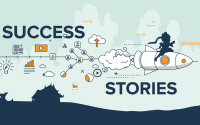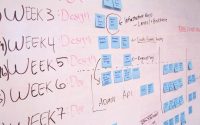Getting into the Mobile App User’s Mind – User Research for Mobile Applications
It’s well understood that user research is what makes for the best user experiences but what are the right user research techniques for mobile apps? While, there is no doubt that any classic UX research technique may be turned to mobile app user research – there are some techniques which have already been demonstrated to show proven value. Mastering these will help you develop better mobile apps that more closely mirror your users’ expectations.
Mobile is the fastest growing way of accessing the internet in the world. Mobile apps constitute the majority of activity on the smartphone platform. This presents huge opportunities for the mobile app developer but in order to get the user experience right; it also presents a big demand for high-quality user research.
By 2017, the global app market will be worth more than $100 billion. That’s a significant chunk of change and to secure some of that market will require great user experiences from mobile apps. Mobile user research is the key weapon in the UX designer’s armoury to conquer some of that market.
Qualitative User Research Methods for Mobile Apps
Qualitative research is concerned with identifying ideas and trends. It is, by definition, not measurable research (you are not collecting numbers) but rather research which provides a flow of concepts that the researcher must analyse to gain insights for product development.
There are 3 key research methodologies for qualitative user research for mobile apps:
- Lab Studies
- Journal/Diary Studies
- Observational/Field Studies
Lab Studies
Lab studies are designed to whether the user can actually use the product. A lab study is conducted using a mobile device in an environment where the user can be observed by the research team. This will often involve the researcher remaining in a different room observing remotely while the user goes about their tasks.
Lab studies are great because they allow the moderator to interact with the subject and ask questions to gain further insights. When set up with high-end equipment the whole team is able to observe the tests and they can easily gather visual cues to the way users feel.
There are issues with conducting lab tests in that they do not bear a 100% resemblance to the real world. They may suffer both from moderator bias and the need that participants often feel to please the moderators with the way that they approach the task.
Author/Copyright holder: Nicholas Wang . Copyright terms and licence: CC BY-SA 2.0
Journal/Diary Studies
A journal/diary study poses the questions; “When do users actually use our app? In what contexts do they use our apps?” and they involve the user writing down the when, how, why and other observations each time they use the app.
Journal studies can be very good at determining how a user actually uses the app and for delivering honest feedback to the research team.
Their biggest drawback is that they rely on the user remembering to note down each use of the app (something that may not feel “pressing” for participants). They also require a lot of management to ensure that they provide the most value.
Observational/Field Studies
You use a field study to determine; “When are users using the app? What context do they use the app in?” A field study requires a researcher to observe (and usually film) a subject as they interact with the app.
This can generate a lot of useful data and is pretty easy on the participants, however, field studies offer no guarantee that the people you are observing are “typical users” who represent the whole user base and they can be intrusive and awkward to carry out.
Author/Copyright holder: visualpun.ch. Copyright terms and licence: CC BY-SA 2.0
Quantitative User Research Methods for Mobile Apps
Quantitative research results in “hard numbers” which can often be more powerful when convincing stakeholders to make a decision than the outputs of qualitative research. However, it’s worth remembering that quantitative research normally answers different questions to qualitative research and both are necessary to develop the best user experiences.
There are 4 main types of quantitative technique used in mobile app research:
- Online Surveys (including Behavioural Tracking)
- Behavioural Analysis
- Automated Logging Activity
- Experience Sample Methods
Online Surveys (including Behavioural Tracking)
Online surveys will involve using a questionnaire combined with automated data collection reflecting the user’s actual behaviour. They are designed to answer the questions; “What do users think of our product? What do they perceive the value to be?”
Online surveys are incredibly cost-effective and can create large amounts of data on a geographically diverse basis which, in turn, leads to statistically significant sample sizes and results.
The down side is that there is no direct contact with the user in large processes like this and you may find that you can identify patterns but can’t deduce the “why this should be?” from them.
Author/Copyright holder: JayWalsh. Copyright terms and licence: CC BY-SA 3.0
Behavioural Analysis
Behavioural analysis works to determine the answer to the “how do people use our app?” question. It is conducted via installed software on the users’ devices that track the way people navigate through the app and/or how they conduct the tasks on your app.
This can be very useful to be certain about what people do as opposed to what they say they do (a perennial problem for researchers) and to understand traffic patterns.
Conversely, the data will not show the user’s context or their intentions. This is why behaviour analysis is often conducted alongside a survey – to try and develop a clearer picture of “why”.
Automated Logging
Another way to answer the “how do people user our app?” question is through automated logging – that records events that are generated on the mobile device and without user input. This is a very good way to ensure that interaction data is objective and consistent. Like behavioural analysis, automated logging is limited in the ability to interrogate context or intent.
Experience Sampling Method (ESM)
This method is particularly useful in mobile user research because it consists of sending automated messages to the study participant at the point they carry out an action to ask about their experience. It helps answer two main questions; “How does the user use our app?” and “What do they think about that?”
There is a risk of introducing cognitive bias into the captured data and studies need to be well-designed to minimize this potential.
The Take Away
There’s no need to throw the baby out with the bathwater. When it comes to user research for mobile apps – all the user research techniques you currently use can be adapted to mobile. However, the tools listed above have been shown to be particularly effective for mobile user research and may be of use as you try to design stronger mobile app user experiences.
References
Hero Image: Author/Copyright holder: JISC. Copyright terms and licence: CC BY-NC-ND 2.0 UK
This content was originally published here.


